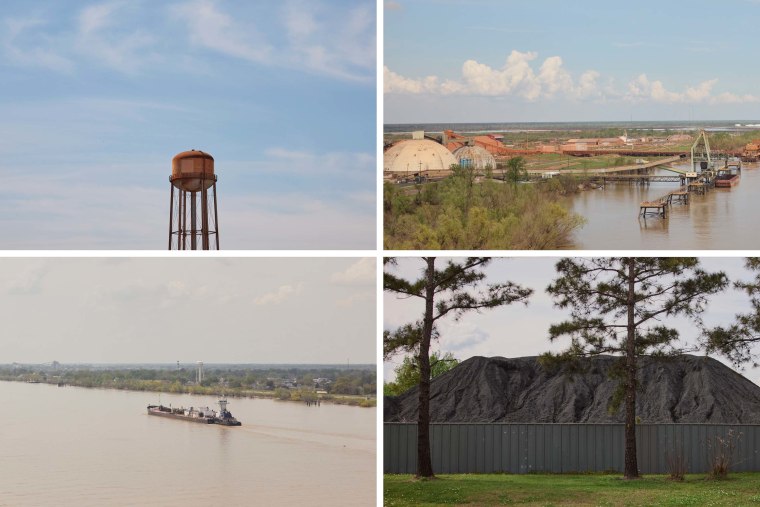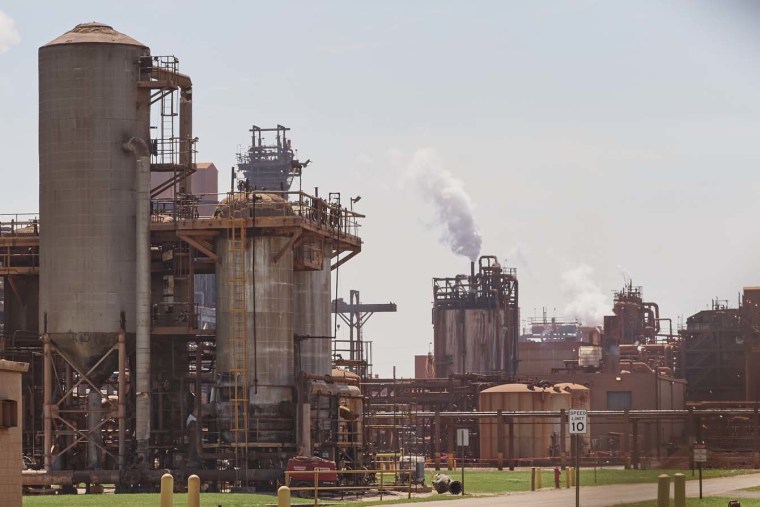President Donald Trump wants to reinvigorate American industry with tariffs on metals, cars and dozens of foreign exporters. In Gramercy, Louisiana, home to the nation’s last refiner of the key material for making aluminum, locals aren’t sold on joining any such revival.
“It would be a good thing to go out of business,” Barbara Dumas, 58, said of the plant she’s lived across the river from for 15 years. Like many residents, she bemoans the area’s industrial pollution and believes her community would be better off without the refinery. “It may hurt the people that’s working there, but at least people around here can live safer.”
Atlantic Alumina, also called Atalco, became the last U.S. refinery of its kind after another one 20 miles away closed in 2020. On the banks of the Mississippi River halfway between New Orleans and Baton Rouge, Atalco’s 550 workers crush, wash and heat Jamaican-mined bauxite in a series of solutions. What starts as a rust-colored rock comes out as powdery white aluminum oxide, a compound known as alumina that resembles sugar but whose granules are hard enough to scratch glass.

The product is sold to smelters to make “primary” aluminum, the raw material that manufacturers turn into everything from beer cans to plumbing parts. The Atalco plant says it single-handedly supplies about 40% of the alumina used in the United States.
If our company closed, we would be the only point of failure for that entire industry.
Mark Hansen, CEO of Atlantic Aluminum's parent company
“It’s been a very difficult operation,” said Mark Hansen, the CEO of Concord Resources, which became Atlantic Aluminum’s majority owner in 2021. The complex, first commissioned in 1957, has been pummeled recently by hurricanes and inflation, but Hansen said it’s important to keep the site running for national security.“If our company closed, we would be the only point of failure for that entire industry in the United States,” he said, noting that the sector has seen “a dramatic decline” in the last two decades.
Trump’s 25% tariffs on foreign-made aluminum, which took effect for most countries March 12 alongside comparable duties on steel, aim to reverse that. The sweeping levies he unveiled Wednesday on virtually all imports could prove a mixed bag, spurring demand for domestic wares while raising many producers’ costs.
Still, tariffs could buoy at least some parts of the domestic aluminum industry, analysts say: By making international supplies pricier, the American-made metal should become more competitive for buyers, at least in the short term.

But the new metal tariffs don’t cover alumina, and Hansen said his modest efforts to lobby Washington policymakers haven’t had much success.“It’s not like we’re Coca-Cola or something,” he said. “We don’t get that level of attention.”
A White House spokesperson said the administration expects the aluminum tariffs to increase the nation’s production capacity for the critical metal, adding that its efforts to reduce energy costs and slash regulations would also boost the primary aluminum industry.
After decades of offshoring some of the most energy-intensive parts of the alumina refining process, the United States makes far less of the material than it uses. Smelters, just four of which remain domestically, rely on imports for about 60% of their alumina needs.
Jobs in the primary aluminum sector have plummeted nearly 70% since 2013, the Aluminum Association estimates. Most job growth has been in secondary aluminum, among “downstream” companies like product fabricators and recyclers. The domestic industry can’t continue to expand without foreign-made primary aluminum, said Charles Johnson, the trade group’s CEO.
“We are very encouraged by some of the actions that President Trump has taken as he has entered office,” he said, including the call to ramp up smelting in the U.S., but Johnson said that process could take a decade. Until then, the downstream sector needs access to foreign supplies — especially from Canada, which the Aluminum Association and other industry stakeholders have urged the administration to spare from tariffs even as they cheer duties on China, a top exporter of cheap metals.
You don’t see butterflies. You don’t see nothing around here.
Willie Youngblood Sr., Vacherie, La.
“It’s not an easy thing” to reboot domestic metal production, said Morris Cohen, a supply chain expert at the University of Pennsylvania’s Wharton School. “It takes time and a lot of effort” and involves “a lot of trade-offs,” he said.Pollution is one of them, according to those who live near the Atalco plant.
“I wouldn’t be breathing too much if I were you,” said Willie Youngblood Sr., “not around here.”
The 67-year-old said he’s watched bauxite shipments roll up to the Gramercy complex for 40 years from his home across the river in Vacherie. Residents of St. James Parish, which includes both communities, say airborne particles from the alumina refinery are contributing to a number of illnesses.

Youngblood, who uses an oxygen tank, partly attributes his lung troubles to the plant’s emissions. He said he doesn’t hang clothes out to dry because the bauxite dust turns everything red.“Your car gets covered with it,” he said. “You don’t see butterflies. You don’t see nothing around here.”
The stretch of the Mississippi River between New Orleans and Baton Rouge is widely known as “Cancer Alley,” an industrial corridor once home to slave plantations and now the site of large petrochemical facilities that regulators and activists have long blamed for the area’s well-documented health problems.
Bauxite refinement generates hazardous waste with high levels of arsenic and chromium along with naturally occurring radioactive materials, according to the Environmental Protection Agency. The Atalco plant was investigated in 2020 by Louisiana regulators for alleged air-quality violations, a matter it settled in 2022 for $75,000 without admitting fault.
If the trade war juices demand for Louisiana alumina and Atalco ramp ups its output in response, locals would suffer, said Anne Rolfes, director of the Louisiana Bucket Brigade, an environmental advocacy group.
“Increased production means a lot more fine particulate pollution for the people” in the area, she said.
St. James Parish, where 47% of the residents are Black, was among a few parts of rural Louisiana where voters didn’t back Trump by large margins. He won it by a single percentage point in November while netting 60% support statewide.
“We need some kind of economic development that’s healthy, not just relying on these big polluters,” Rolfes said.

Hansen said management has addressed concerns about dust from the refinery, which he said is always trying to be a good neighbor.“There’s no overriding concerns that make it an unworthy operation in the American industrial economy,” he said. “It’s been there for longer than I’ve been alive.”
John Fleming, Louisiana’s Republican treasurer, said Trump’s tariff agenda could help businesses like Atlantic Aluminum “because that’s less competition from overseas.” He said the state lost major industrial employers after the North American Free Trade Agreement took effect in 1994.
Look, the United States can outcompete anybody.
John Fleming, Louisiana State Treasurer
“Free trade did not work out well for us because it wasn’t free or fair trade,” he said. “In this case, we’re returning to a fair trade.”“Look,” Fleming added, “the United States can outcompete anybody.”
For now, Hansen is just trying to keep production levels steady and has no plans to expand. If tariffs wind up bolstering U.S. smelting capacity, he said, it could boost Atalco’s customer base — though that would be likely to take years.
“We think there’s a future for that, but it does sometimes involve shorter-term higher costs to make sure that the resiliency of those industries is there,” Hansen said.
Some locals would rather not wait around to see how the refinery fares.
“I’ve been here for about 15 years too long,” said Barbara Dumas in Vacherie. “I’m ready to move back home to some fresh air.”

